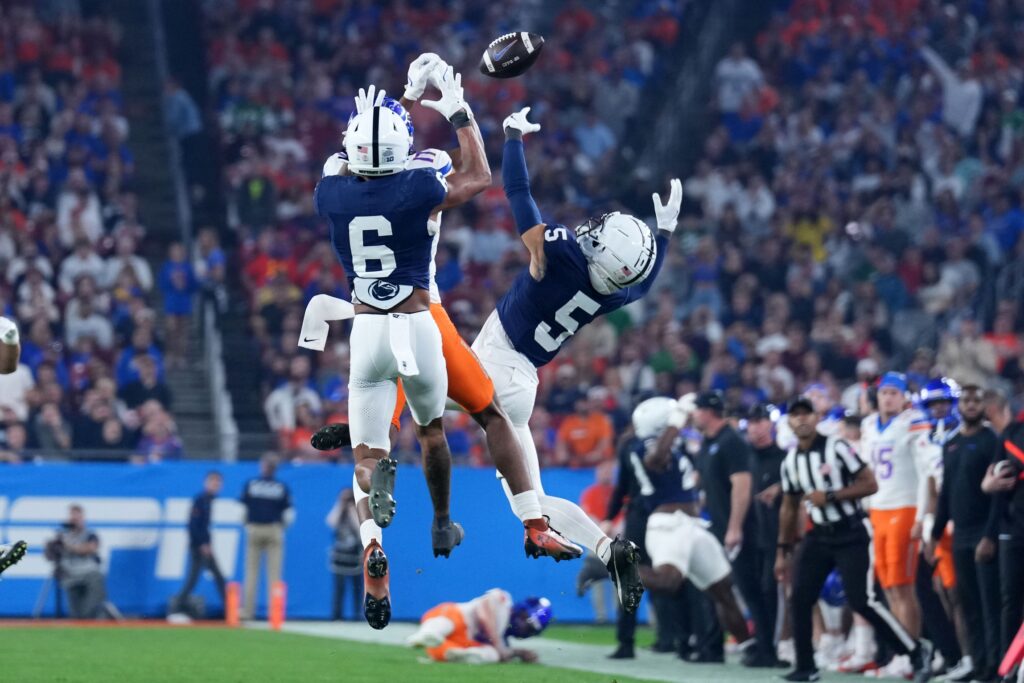As Penn State transitions into Jim Knowles’ version of the 4-2-5 multiple defense, the Nittany Lions’ secondary enters 2025 with a blend of experience and upside.
Veteran Core Anchors a Rebuilt Back End

Returning starters A.J. Harris and Zakee Wheatley provide the foundation. Harris, a junior and former Georgia transfer, earned All-Big Ten honors in 2024 after allowing just one touchdown on 389 coverage snaps, according to PFF. His 6-foot-1, 195-pound frame, press technique, and production make him a natural fit as the boundary corner in Knowles’ scheme. Defensive backs coach Terry Smith told Sports Illustrated that Harris is “one of the best that ever played here”.
Wheatley, now a redshirt senior, started every game last year and recorded 77 tackles, four pass breakups, two forced fumbles, and an interception. Head coach James Franklin praised him as “one of the better pure tacklers on our team” in open space, according to StateCollege.com. As the field safety, Wheatley’s communication and anticipation make him the leader of the back end, especially in a system that emphasizes disguise and rotation.
Harris and Wheatley raise the floor. But Penn State’s ceiling in 2025 hinges on the development of new starters around them.
Cornerback Competition Highlights Depth and Versatility
The battle for CB2, opposite Harris, appears to be settled. Junior Elliott Washington II is expected to start after seeing rotational reps in 2024, including an interception and multiple pass breakups. At 5-foot-11, 190 pounds, Washington’s physicality and spring performance solidified his role. Behind him, redshirt junior Audavion Collins has separated himself as the next man up. A Mississippi State transfer, Collins brings SEC experience and was one of the top rotational performers in spring. His ability to contribute to both base and sub-packages gives the staff added confidence.
True freshman Daryus Dixson, a top-250 prospect from California, could leapfrog redshirt freshmen Kenny Woseley Jr. and Tyler Armstead as the No. 4 corner. Dixson enrolled early and impressed in spring ball with his physical style and college-ready frame. While Woseley and Armstead bring upside, neither has appeared in a game. All three will likely contribute on special teams, but Dixson’s path to early playing time appears more immediate.
Safety Room Brings Physicality and Flexibility
Opposite Wheatley, sophomore Dejuan Lane is the favorite to start at strong safety. Listed at 6-foot-2, 207 pounds, Lane earned first-team reps throughout spring and has the potential to be one of the breakout players on defense. His size and ability to match tight ends align well with the responsibilities of the boundary safety in Knowles’ scheme.
Junior King Mack provides a contrasting skill set with his range and athleticism. After seeing limited action in Tuscaloosa in 2024, Mack flashed during spring ball and could factor into three-safety looks or serve as a big nickel.
Vaboue Toure, Antoine Belgrave-Shorter, and Lamont Payne Jr. round out the depth. Touré’s size (6-1, 209) and downhill speed show on film. Both Payne and Belgrave-Shorter are converted cornerbacks who could bring position versatility. All three are expected to play on special teams with the potential to rotate in dime packages.
Nickel Options and Scheme Flexibility in the 4-2-5
Knowles brings a different philosophy to Penn State’s defensive structure. Under Tom Allen, injuries pushed Penn State into more four-linebacker sets, limiting nickel use. Knowles builds his defense around five defensive backs, rotating between traditional nickel and big nickel alignments.
Junior Zion Tracy leads the way at nickel. He recorded 34 tackles and a pick-six against Ohio State last fall and took the majority of first-team nickel reps in spring. Tracy’s ability to cover in space and blitz off the edge makes him ideal for the role.
However, Knowles has emphasized matchup-specific flexibility. In heavier packages, Lane and Mack may rotate into the nickel spot. Against speed-based offenses, players like Collins or even Harris could slide inside while others rotate outside. Knowles has preached throughout his play-calling career that the best 11 defenders will determine alignment, meaning no role is set in stone.
Execution Will Define the Ceiling
This secondary has the raw talent to become one of the Big Ten’s premier units, but its ultimate success will hinge on communication, discipline, and execution. With veterans Harris and Wheatley anchoring the back end, the pressure shifts to players like Washington II, Lane, and Collins to evolve into consistent, assignment-sound starters. Knowles’ scheme gives Penn State the tools to disguise coverages, dictate tempo, and outmaneuver high-powered passing attacks. If the young core develops quickly and the group plays with cohesion, this secondary won’t just keep Penn State in games—it could be a reason they win them.
Main Image: Matthew O’Haren-Imagn Images
The post Penn State Secondary Preview 2025 Led by Harris, Wheatley appeared first on Last Word on College Football.